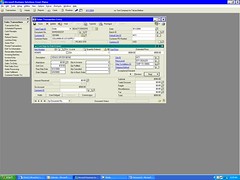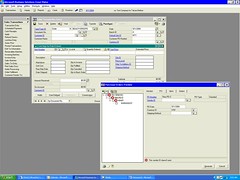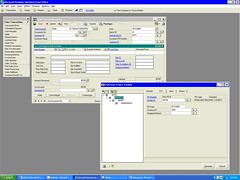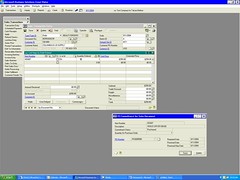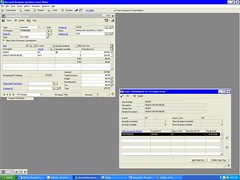I recently attended a user-group meeting hosted by our vendor and they showed us v9.0. I would say there's not much to expect since 8.0 in terms of functionality. Most of the investment were put to technology and I'm very excited with this version. I like the role-based home pages because it's customised or personalized. There are 21 templates available from Accounting/HR/Production/Purchasing/Operations/IT Managers to Dispatcher, Bookkeeper and even Order processor. Other features I'm looking forward includes Metrics in the home pages, KPIs, SQL Reporting Services and SQL 2005 Password Policies. For detailed information on the features I just mentioned, please open the link below and this would open the Microsoft Dynamics GP 9.0 homepage then to the Feature of the Day pages:
https://mbs.microsoft.com/customersource/productsservices/
products/articles/GP90_FeatureofDay.htm
This blog was created to help CIOs, Program leads, solution architects and administrators.
Thursday, December 08, 2005
Tuesday, November 08, 2005
Great Plains ver7.5 Bug Report II
Let me rephrase the title because GP don't use bug, instead I'll use Great Plains ver7.5 Product Report II.
In Smartlist, sometimes a user can accidentally open an object by mistake. In this case instead of using Receivables Transactions, he/she opens Receiving Transactions. If this happen, you'll get this message:
FP: Null Field Address Form: - XX Wind:XXX Fld:XXXX
When you close the message, the Unhandled script exception error opens. Now you can't get out of the error mesaage and you're stuck. The next thing the user needs to do is contact the Great Plains administrator to clear your userid in the database or use User Activity to delete your session.
I've reported this to GP and the PR code is 42126 which they said doesn't appear that it's slated to be addressed in the coming releases.
If you experience the same error on other objects, please go to CustomerSource and report the incident. The more PR code created of the same nature, will move the PR priority even though this isn't a critical error to resolve in the first place.
In Smartlist, sometimes a user can accidentally open an object by mistake. In this case instead of using Receivables Transactions, he/she opens Receiving Transactions. If this happen, you'll get this message:
FP: Null Field Address Form: - XX Wind:XXX Fld:XXXX
When you close the message, the Unhandled script exception error opens. Now you can't get out of the error mesaage and you're stuck. The next thing the user needs to do is contact the Great Plains administrator to clear your userid in the database or use User Activity to delete your session.
I've reported this to GP and the PR code is 42126 which they said doesn't appear that it's slated to be addressed in the coming releases.
If you experience the same error on other objects, please go to CustomerSource and report the incident. The more PR code created of the same nature, will move the PR priority even though this isn't a critical error to resolve in the first place.
Wednesday, October 26, 2005
Tek-tips Question I
I'm going to create a series for Tek-tips questions from Great Plains users. This maybe a simple question or complex question but would be handy for new and old users of the system.
The first would look at Drop-ship sales orders. Here's the user question:
"We are having a problem with the invoicing distributions when we post a drop ship order. We have a mysterious entry showing up at the end that is not visible in the original distribution screen. It is type for inv and cogs. Does anyone one know where it is coming from?"
ANSWER:
Inventory and Cost of Goods Sold are created during invoice posting and should be coming from the sale line item distribution accounts. This is by design because the cost of the items are not known until the invoice is posted.
If the sales line item distribution is blank you can manually enter accounts, some companies do this whenever a non-inventoried item was entered.
If this is an inventoried item, the accounts should be coming from the item card. If the Drop Ship items account is blank on the item card the system would look at the posting setup for inventory (Setup>Posting>Posting Setup>Display:Inventory) then Drop Ship Items.
The first would look at Drop-ship sales orders. Here's the user question:
"We are having a problem with the invoicing distributions when we post a drop ship order. We have a mysterious entry showing up at the end that is not visible in the original distribution screen. It is type for inv and cogs. Does anyone one know where it is coming from?"
ANSWER:
Inventory and Cost of Goods Sold are created during invoice posting and should be coming from the sale line item distribution accounts. This is by design because the cost of the items are not known until the invoice is posted.
If the sales line item distribution is blank you can manually enter accounts, some companies do this whenever a non-inventoried item was entered.
If this is an inventoried item, the accounts should be coming from the item card. If the Drop Ship items account is blank on the item card the system would look at the posting setup for inventory (Setup>Posting>Posting Setup>Display:Inventory) then Drop Ship Items.
Thursday, September 29, 2005
Microsoft Dynamics Brand
I've been reading a lot about the new branding that Microsoft did to its MBS products and I thought why not give my own opinions about it.
Back to old times I would say.
Yesterday, it was Great Plains Dynamics Ctree or Btrieve and Great Plains eEnterprise.
Today, we have Microsoft Business Solutions–Axapta, Microsoft Business Solutions–Great Plains, Microsoft Business Solutions–Navision and Microsoft Business Solutions–Solomon and Microsoft CRM.
Tomorrow, it's going to be Microsoft Dynamics CRM, Microsoft Dynamics GP, Microsoft Dynamics AX, Microsoft Dynamics NAV, Microsoft Dynamics SL.
Do you see any resemblance?
Back to old times I would say.
Yesterday, it was Great Plains Dynamics Ctree or Btrieve and Great Plains eEnterprise.
Today, we have Microsoft Business Solutions–Axapta, Microsoft Business Solutions–Great Plains, Microsoft Business Solutions–Navision and Microsoft Business Solutions–Solomon and Microsoft CRM.
Tomorrow, it's going to be Microsoft Dynamics CRM, Microsoft Dynamics GP, Microsoft Dynamics AX, Microsoft Dynamics NAV, Microsoft Dynamics SL.
Do you see any resemblance?
Monday, August 15, 2005
Error: Failed to Export the Report
When you try to print a document in Great Plains and you're using Forms Printer, you get the following error: Failed to Export the Report.
Solution:
Crystal Reports 8.5: Copy all Crystal Dlls from C:\WINDOWS\Crystal folder to the C:\WINDOWS\system32
Crystal Reports 9.0: Copy the Files in C:\program files\Common Files\Crystal Decisions\2.0\Bin TO C:\WINDOWS\system32
Crystal Reports 10: The path is C:\program files\Common Files\Crystal Decisions\2.5\Bin
The recommended way is to copy the files but don't overwrite any existing files in Windows\system32, but just add the Crystal files.
Solution:
Crystal Reports 8.5: Copy all Crystal Dlls from C:\WINDOWS\Crystal folder to the C:\WINDOWS\system32
Crystal Reports 9.0: Copy the Files in C:\program files\Common Files\Crystal Decisions\2.0\Bin TO C:\WINDOWS\system32
Crystal Reports 10: The path is C:\program files\Common Files\Crystal Decisions\2.5\Bin
The recommended way is to copy the files but don't overwrite any existing files in Windows\system32, but just add the Crystal files.
Adding more audience to this blog
To cater to a broader audience, I've decided to add Crystal Reports. I've been helping a lot of users in MBS Great Plains community site and Tek-tips in how to create, look for sql tables or even linking tables.
Tuesday, August 02, 2005
FRx 6.5 error in Windows Server 2003
We're upgrading all our servers to Windows Server 2003 and the last servers for upgrade were the SQL Server and FRx. When we try to start FRx 6.5, we get Error 339 on CSTEXT32.OCX.
I found an article in CustomerSource on this error:
CAUSE
FRx 6.5 has been installed on a Windows 2003 Server. Service Pack build 6.5.152 (Service Pack 4) has been applied, instead of the Windows 2003 Hot Fix. The Windows 2003 Hot Fix is required in order to successfully start FRx 6.5 on a Windows 2003 server.
RESOLUTION
Download and apply the Windows 2003 Hot Fix on the Windows 2003 server. The Windows 2003 Hot Fix is located on PartnerSource, CustomerSource, and the Great Plains FTP site:
PartnerSource -
https://mbs.microsoft.com/partnersource/products/
greatplains/downloads/hotfixes/frx65w2003hotfix.htm
CustomerSource -
https://mbs.microsoft.com/customersource/support/
downloads/hotfixes/frx65w2003hotfix.htm
I found an article in CustomerSource on this error:
CAUSE
FRx 6.5 has been installed on a Windows 2003 Server. Service Pack build 6.5.152 (Service Pack 4) has been applied, instead of the Windows 2003 Hot Fix. The Windows 2003 Hot Fix is required in order to successfully start FRx 6.5 on a Windows 2003 server.
RESOLUTION
Download and apply the Windows 2003 Hot Fix on the Windows 2003 server. The Windows 2003 Hot Fix is located on PartnerSource, CustomerSource, and the Great Plains FTP site:
PartnerSource -
https://mbs.microsoft.com/partnersource/products/
greatplains/downloads/hotfixes/frx65w2003hotfix.htm
CustomerSource -
https://mbs.microsoft.com/customersource/support/
downloads/hotfixes/frx65w2003hotfix.htm
Friday, July 22, 2005
Database and application versions do not match error in Enterprise Reporting database
When you try to log on to a Microsoft Business Solutions - Enterprise Reporting database, you receive the following error message:
Database and application versions do not match. Please contact your sales representative concerning an upgrade.
This problem occurs if the name of the Microsoft SQL Server database on the server includes a space. Before you follow the instructions in this article, make sure that you have a complete backup copy of the database that you can restore if a problem occurs.
To resolve this problem, rename the database by using a name that does not contain a space.
To rename the database, follow these steps:
1. Start SQL Server Enterprise Manager.
2. Locate the database whose name contains a space. Make sure that you know where the .mdb file for this database is located on the server.
3. Right-click the database, click All Tasks, and then click Detach Database.
4. Right-click Databases, click All Tasks, and then click Attach Database.
5. In the Attach Database dialog box, locate the .mdb file for this database.
6. In the Attach as field, rename the database. Use a name that does not contain any spaces.
7. Update your Open Database Connectivity (ODBC) connection with this new database name.
Database and application versions do not match. Please contact your sales representative concerning an upgrade.
This problem occurs if the name of the Microsoft SQL Server database on the server includes a space. Before you follow the instructions in this article, make sure that you have a complete backup copy of the database that you can restore if a problem occurs.
To resolve this problem, rename the database by using a name that does not contain a space.
To rename the database, follow these steps:
1. Start SQL Server Enterprise Manager.
2. Locate the database whose name contains a space. Make sure that you know where the .mdb file for this database is located on the server.
3. Right-click the database, click All Tasks, and then click Detach Database.
4. Right-click Databases, click All Tasks, and then click Attach Database.
5. In the Attach Database dialog box, locate the .mdb file for this database.
6. In the Attach as field, rename the database. Use a name that does not contain any spaces.
7. Update your Open Database Connectivity (ODBC) connection with this new database name.
Thursday, June 30, 2005
Great Plains 7.5 Service Pack 7 Now Available
The latest service pack for Great Plains 7.5 (Microsoft SQL Server), part of the Dictionary and Utilities service packs, is available for download here:
https://mbs.microsoft.com/customersource/support/
downloads/servicepacks/customerfaqs_gp_75_sp7.htm
https://mbs.microsoft.com/customersource/support/
downloads/servicepacks/customerfaqs_gp_75_sp7.htm
Friday, June 17, 2005
Great Plains ver7.5 Bug Report 1
Scenario:
1) Customer is on Hold
2) Sales line item is drop-ship
When you create a SOP/POP link in ver7.5, the system don't show you any message that the customer is on hold. When you try to generate the Purchase Order, the Purchase Order Generation Register report would show you an error- " The customer is missing".
This bug was fixed in ver8.0, now the Purchase Order Preview window would show you a message that the customer is on hold.
1) Customer is on Hold
2) Sales line item is drop-ship
When you create a SOP/POP link in ver7.5, the system don't show you any message that the customer is on hold. When you try to generate the Purchase Order, the Purchase Order Generation Register report would show you an error- " The customer is missing".
This bug was fixed in ver8.0, now the Purchase Order Preview window would show you a message that the customer is on hold.
Tuesday, June 14, 2005
Hotfix for Smartlist EXP1493.dic file
The hotfix is related to Smartlist. After downloading 8.0 SP2, Great Plains won't open because there were violation of primary keys at login. Here's a more detailed explanation of the hotfix from MBS:
The hotfix is a chunk file for Smartlist EXP1493.dic file. There is a bug with updating to 8.0 if you have Smartlist favorites that were created for a specific user or class.
We fixed this issue in 8.0 SP2, however, this fix created another issue where we violated the primary key on the ASIEXP081 and ASIEXP086 tables to fix that issue.
The hotfix takes care of the violation of primary key issue but also ensures that your Smartlist favorites are still there and available for the user or class as defined in 7.5.
The hotfix is a chunk file for Smartlist EXP1493.dic file. There is a bug with updating to 8.0 if you have Smartlist favorites that were created for a specific user or class.
We fixed this issue in 8.0 SP2, however, this fix created another issue where we violated the primary key on the ASIEXP081 and ASIEXP086 tables to fix that issue.
The hotfix takes care of the violation of primary key issue but also ensures that your Smartlist favorites are still there and available for the user or class as defined in 7.5.
Product Advisory Board
I've filled out the survey and chose the functionalities I think would benefit a lot of industries. Below is a summary of the survey I submitted:
General Ledger
- Allow for voided transactions to flow back to originating module
- control account functionality for cash accounts
Receivables Management
- Ability to enter a negative cash receipt
- Ability to specify how documents should be sorted in the apply window
- Support for centralized cash receipts
- Credit Card processing
Bank Reconciliation
- Ability to enter Bank Transactions in a batch
- Automatically create bank deposits when entering receipts
Payables Management
- Ability to track the 1099 box type for a vendor
- Ability to specify one check per vendor or invoice on the vendor card
eBanking
- Ability to control how EFT for RM transactions are grouped as deposits
- Credit Card reconcililation
Purchase Order Processing
- BOM Suuport in PO Generator
- Request for Quote (RFQ)
Sales Order Processing
- Negative quantities on Sales Order Lines
- Advanced Shipment Notice
- Check for duplicate Customer PO Number
- Controls to prevent duplicate returns
- GL Distributions created per Sales Order/Invoice line
Inventory Control
- Inventory "Freeze" at count time
- Kitting
- Consignment
- Vendor performance
- Physical Count Support
Manufacturing
- Costed BOM Inquiry
- MRP Pegging Window UI
- Multi-Site MRP/DRP
- Mass update pick lists
- MO Reverse Receipt
- Backflushing
- Workflow for ECM approval
General Ledger
- Allow for voided transactions to flow back to originating module
- control account functionality for cash accounts
Receivables Management
- Ability to enter a negative cash receipt
- Ability to specify how documents should be sorted in the apply window
- Support for centralized cash receipts
- Credit Card processing
Bank Reconciliation
- Ability to enter Bank Transactions in a batch
- Automatically create bank deposits when entering receipts
Payables Management
- Ability to track the 1099 box type for a vendor
- Ability to specify one check per vendor or invoice on the vendor card
eBanking
- Ability to control how EFT for RM transactions are grouped as deposits
- Credit Card reconcililation
Purchase Order Processing
- BOM Suuport in PO Generator
- Request for Quote (RFQ)
Sales Order Processing
- Negative quantities on Sales Order Lines
- Advanced Shipment Notice
- Check for duplicate Customer PO Number
- Controls to prevent duplicate returns
- GL Distributions created per Sales Order/Invoice line
Inventory Control
- Inventory "Freeze" at count time
- Kitting
- Consignment
- Vendor performance
- Physical Count Support
Manufacturing
- Costed BOM Inquiry
- MRP Pegging Window UI
- Multi-Site MRP/DRP
- Mass update pick lists
- MO Reverse Receipt
- Backflushing
- Workflow for ECM approval
Saturday, June 11, 2005
Reflect latest data in Analysis Services
One of my favorite update in SQL Server 2000 is the Analysis Services, formerly known in SQL Server 7.0 as OLAP Services. Every SQL Server 2000 administrator should use Analysis Services but this portion of a data warehouse faces certain common operational issues. Analysis Services and its environment must be configured appropriately.
I saw this post recently and found it to be very helpful, as it shows the steps needed to update the cubes in Analysis Services:
When you enter new transactions in Microsoft Business Solutions - Great Plains, you must sometimes also include those transactions in the Microsoft SQL Server 2000 Analysis Services cubes. The "More Information" section describes how to update the cubes with the latest transaction data.
Before you update a cube, you must rerun the Data Transformation Services (DTS) packages that update the data warehouse. You must complete this process in SQL Server Enterprise Manager. To rerun the DTS packages, follow these steps.
Note These steps refer to the sample TWO company in Microsoft Great Plains.
I saw this post recently and found it to be very helpful, as it shows the steps needed to update the cubes in Analysis Services:
When you enter new transactions in Microsoft Business Solutions - Great Plains, you must sometimes also include those transactions in the Microsoft SQL Server 2000 Analysis Services cubes. The "More Information" section describes how to update the cubes with the latest transaction data.
Before you update a cube, you must rerun the Data Transformation Services (DTS) packages that update the data warehouse. You must complete this process in SQL Server Enterprise Manager. To rerun the DTS packages, follow these steps.
Note These steps refer to the sample TWO company in Microsoft Great Plains.
- Click Start, click All Programs, click Microsoft SQL Server, and then click Enterprise Manager.
- Click the Great Plains server folder.
- In the Great Plains server folder, click Data Transformation Services, and then click Local Packages.
- Locate the MSGP_TWO_to_MSGPAnalysisCubesDW_Package_Master_8 master DTS package.
Note Each company has a master DTS package. - Right-click MSGP_TWO_to_MSGPAnalysisCubesDW_Package_Master_8, and then click Execute Package to process the package.
Note Process time will vary based on the amount of data.
- Click Start, click All Programs, click Microsoft SQL Server, click Analysis Services, and then click Analysis Manager.
- Expand MSGPAnalysisCubes.
- Click the Cubes folder, and then locate the cube that you want to update.
- Right-click the cube, and then click Process.
- Click to select the Full check box, the Refresh check box, or the Incremental check box. The check box that you select depends on the type of update that you want to perform.
- Click Start, click All Programs, click Microsoft SQL Server, click Analysis Server, and then click Analysis Manager.
- Right-click MSGPAnalysisCubes, and then click Process the Database.
Note Process time will vary based on the amount of data.
Tuesday, June 07, 2005
SQL Server 2005 Community Technology Preview
SQL Server 2005 is Microsoft's next-generation data management and analysis software designed to deliver increased scalability, availability, and security to enterprise data and analytical applications while making them easier to create, deploy, and manage.
SQL Server June 2005 Community Technology Preview (CTP) is the first version of SQL Server 2005 made available for general testing. Previous versions have been available only to customers enrolled in the SQL Server 2005 beta program or those with an MSDN subscription.
Click here to download.
SQL Server June 2005 Community Technology Preview (CTP) is the first version of SQL Server 2005 made available for general testing. Previous versions have been available only to customers enrolled in the SQL Server 2005 beta program or those with an MSDN subscription.
Click here to download.
Sunday, June 05, 2005
Payable and Receivable Modules Tips
Microsoft Business Solutions–Great Plains technical support engineers Rhonda Sutliff and Kelly Dettmann share tips for using Microsoft Great Plains Payables Management, a module for managing expenses, and Microsoft Great Plains Receivables Management, a module for managing accounts receivable information and transactions.
Click here to their tips.
Click here to their tips.
Saturday, June 04, 2005
Tek-tips Question
Using Great Plains 7.5 with SQL 2000. I k now that updating SQL statistics and recompling SQL stored procedures are recommended for monthly maintenance. Are there any other recommended monthly procedures (checking links, reconciling tables), etc... Any help would be appreciated, this has sort of been put upon me quickly.
My response:
On the database side its mostly DBCC commands. In GP, our monthly task includes but not limited to:
1) Paid Transaction Removal
2) Removal of completed Purchase Orders
3) Removal of completed Sales Orders
4) Removeal of Discontinued Items
5) Removal of Sold Receipts
6) Reconcile Sales Documents (updates Remaining Subtotal, etc.)
7) Reconcile Inventory Quantities
If you have Manufacturing modules:
6) Removal of Cancelled MO's
7) Removal of closed MO's
My response:
On the database side its mostly DBCC commands. In GP, our monthly task includes but not limited to:
1) Paid Transaction Removal
2) Removal of completed Purchase Orders
3) Removal of completed Sales Orders
4) Removeal of Discontinued Items
5) Removal of Sold Receipts
6) Reconcile Sales Documents (updates Remaining Subtotal, etc.)
7) Reconcile Inventory Quantities
If you have Manufacturing modules:
6) Removal of Cancelled MO's
7) Removal of closed MO's
Monday, May 23, 2005
HOW TO CREATE A SALES ORDER AND PURCHASE ORDER LINK PART I
In order to create a Purchase Order link from the Sales Order the item should be on Back Order in the Sales Transaction Entry window.
Click on the Purchase button then the Purchase Orders Preview window will open. In the PO Preview window you can see the mark which means these are required fields to create the Purchase Order link. To fill the required fields you have to open the PO tab and assign a Vendor ID then the Item tab to assign the Vendor Item field.
Once you assign the Vendor ID and Vendor Item mark all the boxes then choose Generate to create the Purchase Order.
The Purchase Order Generation Register will print and will show the Purchase Order created and the Sales Document Number.
A paperclip in the Sales Order line item will indicate that the item is linked to a Purchase Order. To check the link click the right beside the Quantity Ordered field and this will open the PO Commitment for Sales Document window which shows the PO Number.
If you open the Purchase Order created from the Sales Order you could also see a paperclip indicating that it is committed to a Sales Order. The Allow Sales Documents Commitments will be mark automatically to indicate that there is a link. You can open the Sales Commitment for Purchase Order window by choosing the right beside Quantity Ordered.
Click on the Purchase button then the Purchase Orders Preview window will open. In the PO Preview window you can see the mark which means these are required fields to create the Purchase Order link. To fill the required fields you have to open the PO tab and assign a Vendor ID then the Item tab to assign the Vendor Item field.
Once you assign the Vendor ID and Vendor Item mark all the boxes then choose Generate to create the Purchase Order.
The Purchase Order Generation Register will print and will show the Purchase Order created and the Sales Document Number.
A paperclip in the Sales Order line item will indicate that the item is linked to a Purchase Order. To check the link click the right beside the Quantity Ordered field and this will open the PO Commitment for Sales Document window which shows the PO Number.
If you open the Purchase Order created from the Sales Order you could also see a paperclip indicating that it is committed to a Sales Order. The Allow Sales Documents Commitments will be mark automatically to indicate that there is a link. You can open the Sales Commitment for Purchase Order window by choosing the right beside Quantity Ordered.
Sunday, May 22, 2005
Reporting Services screenshot
As promised, here's how the RS looks like after install. I purchased a book in Amazon.com today to help me in implementing RS. After a few minutes of looking at reviews I got - Hitchhiker's Guide to SQL Server 2000 Reporting Services
by Peter Blackburn, William R. Vaughn.
by Peter Blackburn, William R. Vaughn.
Saturday, May 21, 2005
Visit Tek-Tips Forums - Great Plains Software
I've been a member of Tek-Tips since Mar 18, 2003, and as of today had logged in 546 times. Last time I logged in was Sat, May 21, 2005, and since joining had started 69 threads and posted 299 replies.
The SQL Server Web Data Administrator
I've been using Citrix Nfuse for years to access my SQL Server data but when Microsoft released a web interface that can help you manage your SQL Server databases, I downloaded it right away and never looked back. With this tool, called the SQL Server Web Data Administrator, you can:
* Perform ad-hoc queries against databases and save them to your file system.
* Create/edit databases in SQL Server 2000 or MSDE 2000.
* View, create, and edit stored procedures.
* Export and import database schema and data.
* Manage users and roles.
Where do I download?
You can download the SQL Server Web Data Administrator from Microsofts Web site. Before installing it, you must meet the following requirements:
* Windows 2000 SP4, Windows Server 2003, or Windows XP
* SQL Server 7.0 SP2 or higher
* Microsoft .NET SDK or Visual Studio.NET
* IE 5.5 or higher
* IIS
Note: These are the requirements of the machine that the product is being installed on.
* Perform ad-hoc queries against databases and save them to your file system.
* Create/edit databases in SQL Server 2000 or MSDE 2000.
* View, create, and edit stored procedures.
* Export and import database schema and data.
* Manage users and roles.
Where do I download?
You can download the SQL Server Web Data Administrator from Microsofts Web site. Before installing it, you must meet the following requirements:
* Windows 2000 SP4, Windows Server 2003, or Windows XP
* SQL Server 7.0 SP2 or higher
* Microsoft .NET SDK or Visual Studio.NET
* IE 5.5 or higher
* IIS
Note: These are the requirements of the machine that the product is being installed on.
Friday, May 20, 2005
Installing SQL Server Reporting Services
I started installing SQL Server Reporting Services today and saw a lot of required softwares including Visual Studio.Net, IIS and ASP.net. I wasn't prepared for all the software required but was able to complete the install.
On this test server I have Windows 2003 server, SQL Server 2000 Std Edition, SQL Server Analysis Services, MBS Great Plains 8.0 and Crystal Reports 10. Another test server I have my Active Directory, DNS,DHCP, IIS and Microsoft Business Portal 2.5.
I've named the other server TestPortal while this is GPSQLTest. I'll discuss more about the GPSQLTest server. I've been reading about SQL Server SP4 and like the other SP that came before, I will wait and see what others had to say.
On this test server I have Windows 2003 server, SQL Server 2000 Std Edition, SQL Server Analysis Services, MBS Great Plains 8.0 and Crystal Reports 10. Another test server I have my Active Directory, DNS,DHCP, IIS and Microsoft Business Portal 2.5.
I've named the other server TestPortal while this is GPSQLTest. I'll discuss more about the GPSQLTest server. I've been reading about SQL Server SP4 and like the other SP that came before, I will wait and see what others had to say.
Subscribe to:
Comments (Atom)
Digital Transformation unleashed
You're the CIO/CDO sitting in your weekly update executive meeting with the CEO, CFO, COO, and others. You start the meeting with the pr...

-
The first time that you log in to Microsoft Dynamics GP 9.0, you can select to have default information that is specific to your job display...
-
For the past year I've been working on security policies and procedures. One of the most challenging part of security is knowing which t...
-
This month Microsoft announced the availability of Dynamics GP 2013 demo which you can download here . Most of the improvements were geare...
